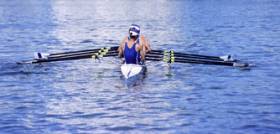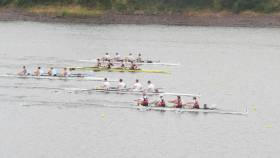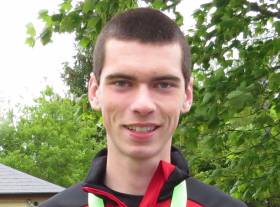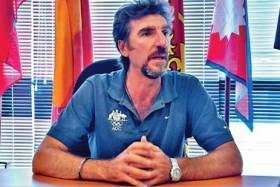Displaying items by tag: Castleconnell
High Water Levels on Shannon Hit Rowing Clubs Hard
Rowing clubs along the Shannon have been badly affected by high water levels. Carrick on Shannon and Athlone have both been hit, while Castleconnell is flooded. This came despite pumping. The gym equipment had been moved out and the boats are stored higher up the bank.
This ESB at Ardnacrusha stated: “Due to heavy rainfall in the catchment we will be increasing discharge from Parteen Weir. You are being notified that water is about to be discharged above 325 m3/sec. This will result in flooding of roads, land and may affect property. You are advised to be aware of increased flows in the river as a result of this water discharge. Further increases in discharge may be required. Approx. 400 m3/sec will be discharged.”
Crowley a Six Shooter at World Masters Regatta
#Rowing: Denis Crowley of Commercial brought his tally of wins to a remarkable six after three days at the World Masters Regatta in Budapest. In just one day, the 57-year-old won in the coxless four and twice in the single sculls – in the C class (43 years or more) and the E class for 55 or more. The decision to form composite crews again paid off for the Irish, with wins in the C eight and the D coxed four, along with Crowley’s haul.
World Masters Regatta, Budapest, (Selected Results, Irish interest, winners)
Friday
Men
Eight
(C – 43 or more): Heat Four: Commercial, Cork, Neptune, Clonmel, Shannon, Galway, Castleconnell (B Crean, B Smyth, R Carroll, O McGrath, G O’Neill, P Fowler, B O’Shaughnessy, K McDonald; cox: M McGlynn) 3:09.75.
Four
(E – 55 or more) Heat Five: Commercial, Neptune, Belfast BC, Galway (D Crowley, G Murphy, C Hunter, A McCallion)
Four, coxed
(D – 50 or more) Heat 3: Galway, Neptune, Castleconnell, Clonmel (G O’Neill, O McGrath, B O’Shaughnessy, T Dunn; cox: M McGlynn) 3:35.89.
Sculling, Single
(C - 43 or more) Heat 19: Commercial (D Crowley) 3:49.92.
(E – 55 or more) Heat 8: Commercial (Crowley)
#Rowing: Commercial won the men's eight in a close and exciting final race of Metropolitan Regatta at Blessington today. UCD and the Irish champions were neck and neck in the final stages, but UCD had the advantage until the sprint to the line, which Commercial won.
The concluding session of finals featured an even closer race.
In the women's four, two junior crews hit the line with just .297 of a second between them. Bann, on the far side of the course from the viewing area, saw their lead snatched away by Castleconnell.
Kenmare's Georgia O'Brien (20) won her singles sculls final with much more to spare, though the second placing gave Aoife Moloney of Commercial victory in the junior 18 rankings.
There were also big margins of victory for Lagan in the men's quadruple and Anna Liffey in the women's pair.
Shane Haugh and James O'Donovan won the men's double. Last weekend O'Donovan was part of the Ireland coxed four which took silver at the European Junior Championships.
Carlow and Castleconnell Notch Up Wins at Ghent
#Rowing: Carlow’s Sadhbh Scully and Keara Egan won the junior 18 women’s double at Ghent regatta on Sunday – first of 18 competing crews. Castleconnell won the women’s junior 18 quadruple, another competitive event, with 10 crews completing the course. Both clubs did well over the two days, as did Three Castles, Methodist College, Belfast, Cork and Commercial, whose senior men’s eight took second on the Sunday.
Ghent Spring Regatta, Belgium (Selected Results; Irish interest):
Saturday
Men
Sculling, Quadruple: 3 Lagan Scullers. Junior: 5 Three Castles.
Double – Jun: 3 Three Castles (L Flynn, A Keogh)
Single – Jun: 5 Cork (P Beechinor) 7:41.32.
Women
Eight – Junior: 1 Commercial 7:25.17.
Four – Jun: 1 Castleconnell 7:32.0, 2 Commercial 7:37.27.
Pair - Senior: 2 Anna Liffey (C Dempsey, D Maguire). Under-23: Cork (J Duggan, C O’Sullivan) 8:11.24. Junior: 1 Cork (J Duggan, C O’Sullivan) 7:59.94, 2 Castleconnell (L O’Brien, N Kiely) 8:04.33.
Sculling
Double – Junior: 5 Carlow.
Lightweight Single: 2 Skibbereen (O Hayes). Under-23: 1 Carlow (K Egan) 8:49.25. Junior: 6 Carlow (S Scully).
Sunday
Men
Eight – Senior: 2 Commercial. Four, coxed- Jun 18: 2 Methodist College, Belfast. Junior 16: 2 Castleconnell.
Sculling, Quadruple: 2 Three Castles.
Double – Jun 18: 4 Cork (Beechinor, M Cronin) 7:08.14.
Single – Under-23 Lightweight: 2 Castleconnell (B Frohburg). Jun 18: 3 Three Castles (Flynn), 5 Three Castles (Tiarnan McKnight), 6 Three Castles (Keogh).
Women
Four – Jun: 1 Commercial 7:41.73, 2 Castleconnell.
Pair – Sen: 3 Anna Liffey (Dempsey, Maguire). Under-23: Cork (Duggan, O’Sullivan) 8:47.59. Jun: Cork (Duggan, O’Sullivan) 8:12.36, 3 Commercial.
Sculling, Quadruple – Jun 18: 1 Castleconnell 7:21.72. Jun 16: 3 Castleconnell, 4 Carlow.
Double – Jun 18: 1 Carlow (Scully, Egan) 7:58.26.
Single – Lightweight: 2 Skibbereen (Hayes). Lwt U-23: 1 Carlow (Egan) 8:56.71. Jun 18: 3 Carlow (Scully); 5 Cork (H Gahan).
O'Donovan and O'Neill Shine in Dirty Dozen Test
#Rowing: Rory O’Neill and James O’Donovan of Castleconnell shared top billing in the men’s junior 18 rankings after the concluding stage of the Dirty Dozen Challenge. Eabha Benson of St Michael’s won the women’s junior 18 series. There were four rounds, beginning in October (three kilometres) and running through November (5k) and December and January (6k).
| Category | Shell | Rower(-s) | Bow # | Place | Course time |
|---|---|---|---|---|---|
| W J16 | 1X | C. Leahy | 112 | 1 | 00:14:50 |
| W J16 | 1X | J. O'Brien (CCBC) | 110 | 2 | 00:14:51 |
| W J16 | 1X | R. Hickey (Shannon Rowing Club) | 114 | 3 | 00:15:00 |
| W J16 | 1X | C. Kiely (Castleconnell) | 109 | 4th | 00:15:02 |
| W J16 | 1X | G. Fitzgerald (CCBC) | 113 | 5th | 00:15:29 |
| W J16 | 1X | C. Ni Dhonabhain (SRC) | 111 | DNF | |
| W J18 | 1X | �. Benson (SMRC) | 76 | 1 | 00:28:45 |
| W J18 | 1X | N. Kiely (Castleconnell BC) | 74 | 2 | 00:29:04 |
| W J18 | 1X | C. KIRWAN (SMRC) | 75 | 3 | 00:29:58 |
| W J18 | 1X | S. Gilmore (CCBC) | 77 | 4th | 00:30:00 |
| W J18 | 1X | S. Fitzgerald (TRC) | 78 | 5th | 00:31:05 |
| W J18 | 1X | C. Storan (SMRC) | 82 | 6th | 00:31:42 |
| W J18 | 1X | C. Kelly (Castleconnell BC) | 79 | 7th | 00:33:37 |
| W J18 | 1X | A. King (SMRC) | 81 | 8th | 00:33:48 |
| W J18 | 1X | H. Bradshaw (CCBC) | 80 | 9th | 00:34:12 |
| W J18 | 1X | O. Murphy (St Michaels) | 84 | 10th | 00:34:47 |
| W J18 | 1X | �. Phillips (SMRC) | 83 | 11th | 00:37:41 |
| W J18 | 1X | L. O'Brien (Castleconnell Boat Club) | 73 | DNF | |
| W OPEN | 1X | E. Redlichova (SMRC) | 85 | DNF | |
| W U21 | 1X | C. O'Brien (Castleconnell boat club) | 86 | 1 | 00:28:37 |
| W U23 | 1X | S. Murphy (SMRC) | 87 | 1 | 00:32:03 |
| W U23 Lt Wt | 1X | N. Hartney (SMRC) | 88 | 1 | 00:29:34 |
| W J16 | 2- | F. Gleeson (Shannon rowing club) | |||
| A. Curtin (shannon rowing club) | 116 | 1 | 00:13:38 | ||
| W J16 | 2- | E. McMahon (CCBC) | |||
| T. Mulready (Ccbc) | 117 | 2 | 00:14:04 | ||
| W J16 | 2- | C. Gleeson (Shannon rowing club) | |||
| A. Caffrey (Shannon) | 115 | DNF | |||
| W J18 | 2- | S. Byrnes (CCBC) | |||
| N. Silke (Castleconnell boat club) | 92 | 1 | 00:27:44 | ||
| W J18 | 2- | E. Mcinerney (Smrc) | |||
| E. Murphy (SMRC) | 89 | 2 | 00:28:15 | ||
| W J18 | 2- | A. Mckeon (Smrc) | |||
| M. O'Byrne (SMRC) | 93 | 3 | 00:29:10 | ||
| W J18 | 2- | N. Jones (SMRC) | |||
| K. McGann (SMRC) | 94 | 4th | 00:30:51 | ||
| W J18 | 2- | S. Broggy (Athlunkard Boat Club) | |||
| M. Malone (Athlunkard Boat Club) | 90 | 5th | 00:31:08 | ||
| M J16 | 1X | P. Mcinerney (Smrc) | 105 | 1 | 00:13:11 |
| M J16 | 1X | D. Foley (SMRC) | 103 | 2 | 00:13:12 |
| M J16 | 1X | G. O'Donoghue (Shannon Rowing Club) | 97 | 3 | 00:13:21 |
| M J16 | 1X | J. Cunningham (Castleconnell) | 96 | 4th | 00:13:41 |
| M J16 | 1X | T. Byrne | 99 | 5th | 00:13:44 |
| M J16 | 1X | I. Byrne Delimata (Castleconnell) | 98 | 6th | 00:13:49 |
| M J16 | 1X | D. De Brun (SMRC) | 104 | 7th | 00:13:59 |
| M J16 | 1X | N. Larkin Damm (Tralee Rowing CLUB) | 102 | 8th | 00:14:47 |
| M J16 | 1X | S. Cunningham (CCBC) | 100 | DNF | |
| M J16 | 1X | C. Oconnell (Waterville lake rowing cl...) | 101 | DNF | |
| M J18 | 1X | R. O'Neill (Castleconnell) | 59 | 1 | 00:25:39 |
| M J18 | 1X | J. O Donovan (CCBC) | 57 | 1 | 00:25:39 |
| M J18 | 1X | M. English (St Michaels Rowing Club) | 58 | 3 | 00:26:59 |
| M J18 | 1X | J. Scanlon France (ABC) | 60 | 4th | 00:32:50 |
| M J18 Lt Wt | 1X | B. France (St. Michaels) | 61 | 1 | 00:28:22 |
| M J18 Lt Wt | 1X | C. Bowen (Castleconnell boat club) | 62 | 2 | 00:29:03 |
| M Master B | 1X | R. Egan (Ccbc) | 63 | 1 | 00:27:01 |
| M Master C | 1X | c. Byrne (CCBC) | 64 | 1 | 00:28:32 |
| M OPEN | 1X | D. O'Connor (St. Michael's Rowing...) | 50 | 1 | 00:24:45 |
| M U21 | 1X | R. Spelman (Smrc) | 51 | 1 | 00:25:23 |
| M U21 | 1X | C. Mulready (Castleconnel) | 52 | 2 | 00:26:53 |
| M U21 | 1X | J. Desmond (Caslteconnell) | 53 | 3 | 00:28:16 |
| M U21 | 1X | A. King (Athlunkard Boat Club) | 54 | DNF | |
| M U23 | 1X | A. Lennon (St Michaels Rowing Club) | 55 | DNF | |
| M J15 | 2- | R. Lyons (Castleconnell) | |||
| A. SWEENEY (Ccbc) | 106 | 1 | 00:13:22 | ||
| M J16 | 2- | E. Gilmartin (CCBC) | |||
| J. McGrath (CCBC) | 107 | 1 | 00:12:48 | ||
| M J16 | 2- | P. Mcinerney (Smrc) | |||
| D. Hartney (SMRC) | 108 | 2 | 00:13:28 | ||
| M J18 | 2- | R. O Gorman (St.Michaels Rowing Club) | |||
| D. Hartney (SMRC) | 69 | 1 | 00:25:36 | ||
| M J18 Lt Wt | 2- | S. Fitzgerald (CCBC) | |||
| C. Nolan (Castleconnell) | 70 | 1 | 00:26:50 | ||
| M J18 Lt Wt | 2- | C. Foster (SMRC) | |||
| C. Kemp (SMRC) | 72 | 2 | 00:27:46 | ||
| M J18 Lt Wt | 2- | A. McFerran (CCBC) | |||
| E. Healy (Castleconnell Boat Club) | 71 | 3 | 00:28:09 | ||
| M Master B | 2- | P. Williams (CCBC) | |||
| E. Meskell (CCBC) | 65 | 1 | 00:26:05 | ||
| M Master C | 2- | k. mc donald | |||
| M. O'Callaghan (Shannon rowing club) | 66 | DNF | |||
| M U21 | 2- | J. O Brien (Castleconnel Boat Club) | |||
| C. Feely (Castleconnel rowing club) | 67 | DNF | |||
| M U23 | 2- | T. McKeon (St. Michael's rowing...) | |||
| J. Cuddy (SMRC) | 68 | 1 | 00:24:31 |
Cork Clubs Come to Fore at Irish Rowing Championships
#Rowing: UCC brought their title tally to three as they added the club coxed four to their club eights and intermediate single sculls pots at the Irish Rowing Championships today. The four was tested by four other crews coming to the line but broke free and won. The morning session on the Sunday was held in intermittent light rain.
Margaret Cremen won the women’s lightweight single sculls. The Lee woman looked dominant through much of the race, but as she approached the line she was hunted down by Orla Hayes of Skibbereen, who closed to just a few seconds on the line. Hayes’s clubmate, Aodhan Burns, left no doubts as to his intentions in the men’s lightweight single. He left the rest behind and won well.
The men’s intermediate pair gave Shandon a chance to demonstrate the depth of their talent pool. Stephen O’Sullivan and Colm Hennessy teamed up to win. The Castleconnell junior double of James Desmond and Rory O’Neill came under pressure from Lee in their win.
One of the closest races in the Championships so far came in the women’s intermediate four. Leaders Trinity were pipped on the line by Cork, whose winning margin was under a third of a second (.312).
Killorglin’s Anna Tyther and Rhiannon O’Donoghue gave Fermoy a test in the women’s junior pair. Gill McGirr and Eliza O’Reilly are an excellent crew, however, and held off their Kerry rivals.
Irish Rowing Championships, Day Three (Selected Results)
Men
Four – Club, coxed: UCC A 6:38.03.
Pair – Inter: Shandon A 6:56.07.
Sculling, Double – Junior: Castleconnell (R O’Neill, J Desmond) 6:49.97.
Lightweight Single: Skibbereen (A Burns) 7:20.56.
Women
Four – Inter, coxed: Cork 7:22.36.
Pair – Junior: Fermoy (E O’Reilly, G McGirr) 7:48.69.
Sculling, Lightweight Single: 1 Lee (M Cremen) 8:06.97.
#Rowing: Commercial finished second to Leander in the men’s Championship Eights at London Metropolitan Regattta at Dorney Lake today. It was one of a string of good results for Irish clubs. NUIG and Tribesmen shone and teamed up to win the women’s Championship coxed four. UCC – who took second in the Championship single sculls through Ronan Byrne – also excelled. Trinity, the University of Limerick, Shandon and Castleconnell also had wins.
London Metropolitan Regatta, Dorney Lake (Irish interest; selected results, winners unless stated)
Men
Eight – Championship: 1 Leander 5:49.90, 2 Commercial 5:52.74.
Four – Championship: 3 Commercial 6:12.20. Tier Two: Shandon.
Four, coxed – Tier Three: Tribesmen 6:32.26. Academic, Tier Two: NUIG.
Pair – Tier Two: UCC 7:14.93.
Double Sculls – Championship: 2 UCC (R Byrne, H Sutton) 6:32.50. Tier Two: Castleconnell 6:42.50.
Single Sculls – Championship: 2 UCC (R Byrne) 7:03.99. Tier Two: Univ of Limerick (K Mannix) 7:18.36. Tier Three: St Michael’s (D O’Connor).
Women
Eight – Club, Tier Two: NUIG/Tribesmen 6:50.64. Academic, Tier Two: Trinity 6:57.77.
Four – Academic, Tier Two: Trinity 7:08.62.
Four, coxed – Championship: NUIG/Tribesmen 7:20.88. Tier Four: Univ of Limerick.
Pair – Championship: 2 Commercial (H O’Neill, R Morris) 7:46.57. Tier Two: NUIG 7:39.84.
Double Sculls – Championship: 3 London/Skibbereen (M Jackson, N Long) 7:28.48.
#Rowing: Castleconnell won the award as best junior club at Ghent International Regatta today. Their boys and girls reeled off a set of impressive results over the two days: on Sunday, the women’s junior pair won, while there were second places for the junior men’s four, pair and double and the junior women’s quadruple, which took on international-class Belgian opposition. The women’s under-23 double also won.
Saturday had been good for a number of Ireland clubs. Forty-one crews competed in the men’s junior single sculls – and Irish crews filled the first two places. Jack Butler of King’s Hospital won, with Rory O’Neill of Castleconnell just two seconds slower. The Castleconnell junior men’s four won and their women’s junior double of Niamh Kiely and Lauren O’Brien took second amongst 51 crews which competed.
Over the two days, other Irish crews to record wins included Skibbereen – which won both the women’s senior pair and the men’s junior 16 quadruple – and Commercial, which on Saturday won the junior women’s pair through Aoife Molony and Grace Healy and the junior women’s eight.
At Lee Regatta on Saturday, Shandon won the junior men’s 18 eight and Cork the women’s junior 18 eights.
Ghent International May Regatta (Irish interest, selected results)
Saturday
Men
Four – Junior: 1 Castleconnell.
Pair – Jun: 2 Castleconnell (J O’Donovan, C Mulready); 3 Castleconnell (B Frohburg, D Ryan)
Sculling, Quadruple – Jun 18: 3 Skibbereen (D Kavanagh, E O’Connor, F O’Reilly, F O’Regan). Jun 16: 1 Skibbereen (Kavanagh, O’Connor, O’Reilly, Regan).
Single – Jun: 1 King’s Hospital (J Butler), 2 Castleconnell (R O’Neill).
Women
Eight – Jun: 1 Commercial, 2 Carlow. Pair – Jun: 1 Commercial (A Molony, G Healy).
Sculling, Quadruple – Jun: 2 Castleconnell (N Kiely, L O’Brien, N Silke, S Byrnes).
Single – Under-23: 3 Castleconnell (P Silke).
Double – Jun: 3 Castleconnell (N Kiely, L O’Brien).
Single – Under-23: 2 Castleconnell (C O’Brien). Lightweight Single – Sen: 3 Skibbereen (O Hayes).
Sunday
Men
Four – Jun: 2 Castleconnell (B Frohburg, J O’Donovan, C Mulready, D Ryan)
Pair – Jun 18: 2 Castleconnell (O’Donovan, Mulready), 3 Castleconnell (Frohburg, Mulready), 3
Sculling
Double – Jun: 2 Castleconnell (J Desmond, R O’Neill). Jun 16: 3 Skibbereen (E O’Connor, F O’Reilly)
Women
Eight: 2 Commercial, 3 Carlow.
Pair – Sen: 1 Skibbereen (A McCarthy, N Casey), 2 Commercial (H O’Neill, R Morris). Jun: 1 Castleconnell (N Silke, S Byrnes); 3 Commercial (A Moloney, G Healy).
Sculling, Quadruple: 2 Castleconnell.
Double – U-23: 2 Castleconnell (C O’Brien, S Gilmore). Jun 16: 2 Carlow (S Scully, K Egan).
Single – Lightweight: 3 Skibbereen (O Hayes).
Mannix Top Sculler at Limerick Rowing Regatta
#Rowing: Kealan Mannix won both the senior and intermediate single sculls at Limerick Regatta today. The Skibbereen man was competing for University of Limerick, who also won in the senior fours. Muckross were the top men’s club eight, while Galway won the women’s intermediate and junior eights. Castleconnell were the top men’s junior 18 eight.
Limerick Regatta, Saturday (Selected Results):
Men
Eight – Club: Muckross. Junior 18: Castleconnell. Jun 16: Col Iognaid.
Four – Sen: University of Limerick. Inter, coxed: Clonmel. Jun 18A, coxed: Castleconnell.
Pair – Sen: Portadown.
Sculling, Quadruple – Novice, coxed: Univ of Limerick. Jun 18A: CRCC.
Double – Inter: St Michael’s B.
Single – Sen: Univ of Limerick (K Mannix). Inter: University of Limerick (K Mannix). Jun 18A: St Michael’s (R Spelman).
Women
Eight – Inter: Galway. Jun 18: Galway. Jun 16: Commercial. Masters: University of Limerick.
Four – Inter, coxed: Fermoy. Jun 18: Shandon.
Pair – Jun 18: CRCC.
Sculling, Quadruple – Jun 18: Castleconnell. Jun 16, coxed: Commercial A.
Double – Inter: St Michael’s.
Single – Inter: Castleconnell (C O’Brien). Jun 18A: Castleconnell (O’Brien).
#Rowing: Rowing Ireland have announced that an anonymous financial donation from the USA, facilitated through The Ireland Funds, has been granted to Castleconnell Boat Club and the Rowing Ireland High Performance Programme. The injection of funds will allow the facilities at Castleconnell BC to be upgraded accordingly, as well as facilitating the purchase of boats and equipment for the Rowing Ireland HP Programme – specifically development of heavyweight men, who will be training at Castleconnell under HP coach James Mangan.
Outgoing Rowing Ireland CEO, Hamish Adams, said “We’re delighted to receive another generous donation through The Ireland Funds who we have been working with for several years. These monies are critical to the development of our athletes and our sport as a whole. James has been instrumental in developing links with American donors and he will be a key driver of the heavyweight development programme in Castleconnell.”
President of Castleconnell BC, Owen Silke also commented saying, “We are very excited about this development. It is a fantastic opportunity for any athlete who wants to try and progress to the Irish team. Our goal is to develop rowers as part of a high performance pathway to meet the standards set out by HP Director Antonio Maurogiovanni.”





































































